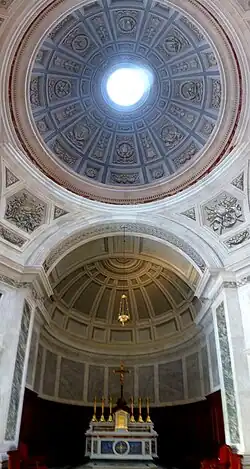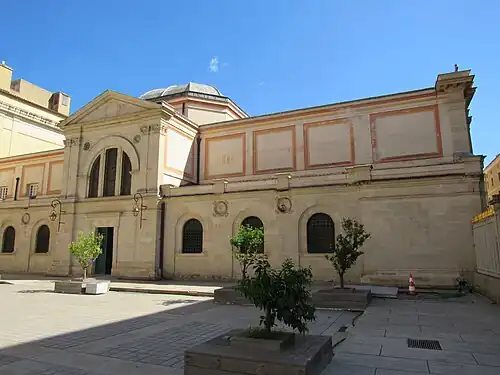Imperial Chapel of Ajaccio
| Imperial Chapel | |
|---|---|
Chapelle Impériale | |
 The interior of the Imperial Chapel in Ajaccio | |
| Location | Ajaccio, Corsica, France |
| Denomination | Catholic |
| History | |
| Status | Chapel |
| Consecrated | 9 September 1860 |
| Architecture | |
| Architect(s) | Alexis Paccard |
| Style | Neo-Renaissance |
| Completed | 1859 |
| Specifications | |
| Materials | Stone, marble |
| Administration | |
| Diocese | Diocese of Ajaccio |
The Imperial Chapel (French: La Chapelle Impériale) , also known as the Palatine Chapel,[1] is a Roman Catholic chapel in Ajaccio, Corsica, France. Commissioned by Napoleon III and built between 1857 and 1859, it was designed by Alexis Paccard in the Neo-Renaissance style to honour the last wishes of Cardinal Joseph Fesch. It serves as the final resting place of several members of the Bonaparte family, including Napoleon I's mother, Letizia Bonaparte. The chapel is part of the Palais Fesch complex, home to the Fesch Museum, and was designated a Monument historique in 1924.[2]
History
Before the construction of the Imperial Chapel, members of the Bonaparte family were buried in the crypt of Ajaccio Cathedral. Cardinal Joseph Fesch, maternal uncle of Napoleon I, expressed a desire to be buried in a separate chapel alongside his sister Letizia (Napoleon’s mother) and any other members of the Bonaparte family who wished to be interred there. Fesch died in 1839, his final request was not fulfilled until nearly two decades later. In 1857, Napoleon III ordered the construction of the chapel to honour his great-uncle’s wishes.[3]
Construction was completed in two years, and the chapel was consecrated on 9 September 1860 in the presence of Napoleon III and Empress Eugénie..[4] It stands within the right wing of the Palais Fesch, where Cardinal Fesch’s extensive collection of European paintings is housed.[1]
On 22 July 1924, the Imperial Chapel was designated a Monument historique by the French Ministry of Culture. In October 2021, as part of the Bicentenary of the death of Napoleon I, the site was opened to the public for guided tours.[3]
Architecture
Designed in the Neo-Renaissance style by Alexis Paccard, architect of Napoleon I's tomb at Les Invalides, the Imperial Chapel follows a Latin cross layout and is built from local Saint-Florent stone. Its façade features rounded arches and sculptural detailing, while the interior is adorned with marble.[4]
The chapel’s interior is notable for its ornamental paintings by Jérôme Maglioli and stained glass windows. A distinctive feature is the Ankh cross displayed above the altar, said to have been brought back by Napoleon from his Egyptian campaign.[1]
Inscription
Above the entrance, a marble plaque bears a Latin inscription dedicating the chapel to Maria Letizia and Cardinal Fesch, with a final invocation for eternal rest in Christ.[5]
MARIAE LAETITIAE IMP. NEAPOLEONIS MATRI ET IOS. FESCH S.R.E. CARDINALI
QUI VIVUS SIBI ET SORORI OPTIMAE ET SUIS HOC SEPULCRALE SACELLUM INSTITUIT
AUSPICIIS NEAPOLEONIS III PERFECTUM EST A.D. MDCCCLIX
AETERNAM IN CHRISTO REQUIEM
To Maria Letizia, mother of Emperor Napoleon I, and to Joseph Fesch, Cardinal of the Holy Roman Church, who in his lifetime established this sepulchral chapel for himself, his excellent sister, and his family. Completed under the auspices of Napoleon III in the year 1859.
Eternal rest in Christ.[5]
Burials
The crypt houses the remains of several Bonaparte family members:[3]
- Carlo Buonaparte (1746–1785), father of Napoleon I (reinterred 1951)
- Letizia Bonaparte (1750–1836), Napoleon I’s mother
- Cardinal Joseph Fesch (1763–1839), maternal uncle of Napoleon I
- Charles Lucien Bonaparte (1803–1857)
- Zénaïde Bonaparte (1860–1862)
- Louis Lucien Bonaparte (1813–1891)
- Napoléon-Charles Bonaparte (1839–1899)
- Victor Napoleon (1862–1926)
- Clémentine of Belgium (1872–1955), wife of Victor Napoléon
- Louis, Prince Napoléon (1914–1997), their son
Heritage Status
The chapel was designated a Monument historique of France on 22 July 1924.[4] It remains a significant site of Napoleonic memory and is open to the public as part of the Palais Fesch complex, which also includes the Fesch Museum.[3]
Gallery
-
.jpg) View of the nave and altar
View of the nave and altar -
4.jpg) Entrance to the Bonaparte family crypt
Entrance to the Bonaparte family crypt -
 Exterior façade of the chapel in Ajaccio
Exterior façade of the chapel in Ajaccio
See also
References
- ^ a b c Auzias, Dominique; Labourdette, Jean-Paul (10 April 2024). Lieux De Mémoire En France 2024 (in French). Petit Futé. p. 88. ISBN 978-2-305-10506-2.
- ^ "Museum of Fine Arts". Ville Impériale. 22 May 2020.
- ^ a b c d "Imperial chapel". napoleon.org. 31 December 2000.
- ^ a b c "Bonaparte family crypt". Ajaccio Tourism. 4 January 2025.
- ^ a b "La Chapelle imperiale d'Ajaccio". napoleon-monuments.eu (in French).